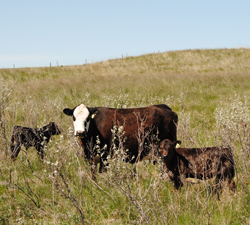ForageBeef.ca Gets a Facelift

This article written by Dr. Reynold Bergen, BCRC Science Director, originally appeared in the June 2019 issue of Canadian Cattlemen magazine and is reprinted on the BCRC Blog with permission of the publisher.
Canada’s National Beef Strategy has four goals that our industry aims to achieve by 2020. For the past year this column has explained how research is contributing to a 15% increase in carcass cut-out value (the Beef Demand pillar), a 15% improvement in production efficiency (Productivity), and a 7% reduction in cost disadvantages compared to Canada’s main competitors (Competitiveness). The fourth goal (Connectivity) is about improving communication within industry and with consumers, the public, government and partner industries. Research contributes science-based information to underpin fact-based communication, policy and regulation, as well as extension (also known as technology transfer) activities to translate research results into improved on-farm production and management practices.
Extension used to be a core mandate for governments and universities; they all had extension staff, held field days and published producer-focused bulletins. Some researchers are still active in extension, but most institutions have shifted their focus to scientific research and technology development. The private sector has filled the extension gap in spots, especially where there is a clear profit motive for the company or individual doing the extension. This often works best when there is a product to sell, like a nutritional supplement, vaccine, or electric fencer. It is more challenging for the private sector to justify extension when the product is a management practice that is hard for a company to charge for, needs to be highly customized to suit individual operations, or primarily benefits the customer. Examples include low-cost winter feeding, crossbreeding, rotational grazing, and low-stress handling. Private sector extension can also be difficult with practices that benefit the overall industry but might not directly or immediately profit any specific individual (e.g. some animal welfare practices, antimicrobial and environmental stewardship). The BCRC tries to fill those gaps.
The BCRC’s first dipped its toe into extension when we co-funded www.foragebeef.ca in 2002. This initiative was spearheaded by AAFC’s Duane McCartney and became a comprehensive forage resource that Alberta Agriculture maintained as a standalone website. Consequently, the BCRC didn’t develop competing forage resources when we created our www.beefresearch.ca as a credible, one-stop-shop for beef and cattle research, production and management information.
Times change though. In 2018, Alberta’s government decided that it couldn’t maintain www.foragebeef.ca as a separate website. The BCRC was presented with three options. One was to leave www.foragebeef.ca alone but not maintain it, letting it gradually erode as links got broken and content became outdated. A second was to transition some select content onto Alberta Agriculture pages. A third option was to incorporate www.foragebeef.ca into www.beefresearch.ca. That’s the option we chose, with support from the Alberta government via the Alberta Beef, Forage and Grazing Centre. That’s why you’ve been directed to www.beefresearch.ca if you’ve looked for www.foragebeef.ca lately.The BCRC has an archived copy of the www.foragebeef.ca content, and we are gradually updating, repackaging, and transferring it to the Forage and Grasslands section of www.beefresearch.ca. This will take time, given the amount of information involved. Our first step was to conduct web analytics to learn which www.foragebeef.ca topics are most popular. We’re using that information to prioritize the topics we update and edit. For example, the www.foragebeef.ca Drought Management page was recently updated and posted on www.beefresearch.ca.
The way things look today, drought will be on the minds of a lot of producers attending the Canadian Beef Industry Conference (CBIC) in Calgary on August 13-15. The CBIC is co-hosted by the BCRC, Canada Beef, Canadian Beef Breeds Council, the Canadian Cattlemen’s Association, and the National Cattle Feeder’s Association. The CBIC’s Bov-Innovation session is a popular workshop full of tips and ideas that producers can take home and adopt. Bov-Innovation pairs an expert explaining the science behind best practices with a leading producer explaining how they have adopted these practices to benefit their cattle and their profitability. This year’s topics chosen from producer suggestions are:
- “Dealing with Drought” will pair Dr. John McKinnon with Graeme Finn (Crossfield, Alberta) to address the challenge of cost-effectively meeting the beef cow’s current and future nutritional requirements for maintenance, lactation, and reproduction when feed is scarce and expensive, while still endeavoring to maintain a healthy forage stand.
- “Alternatives to Antimicrobials” will see Dr. Steve Hendrick of the Coaldale Veterinary Clinic and rancher Stephen Hughes from Longview, Alberta discuss strategies to reduce the need for antimicrobials on your operation, and how this can benefit you.
You’re also invited to join us on the afternoon of Thursday, August 15th, as the BCRC explains how research and technology transfer is impacting farms and ranches across Canada. Examples of innovation and progress will be shared as well as ideas of future objectives and research priorities. Conference registration is not required for the Thursday open house.

Registration for the CBIC is now open and producers are encouraged to register soon. Participants who register before June 15th will take advantage of a reduced rate and guarantee their spot at this event. Information on the full conference, as well as registration, accommodations, flights, and agenda can be found at www.canadianbeefindustryconference.com. We hope to see you there!
The Beef Research Cluster is funded by the Canadian Beef Cattle Check-Off and Agriculture and Agri-Food Canada with additional contributions from provincial beef industry groups and governments to advance research and technology transfer supporting the Canadian beef industry’s vision to be recognized as a preferred supplier of healthy, high quality beef, cattle and genetics.
Click here to subscribe to the BCRC Blog and receive email notifications when new content is posted.
The sharing or reprinting of BCRC Blog articles is typically welcome and encouraged, however this article requires permission of the original publisher.
We welcome your questions, comments and suggestions. Contact us directly or generate public discussion by posting your thoughts below.
